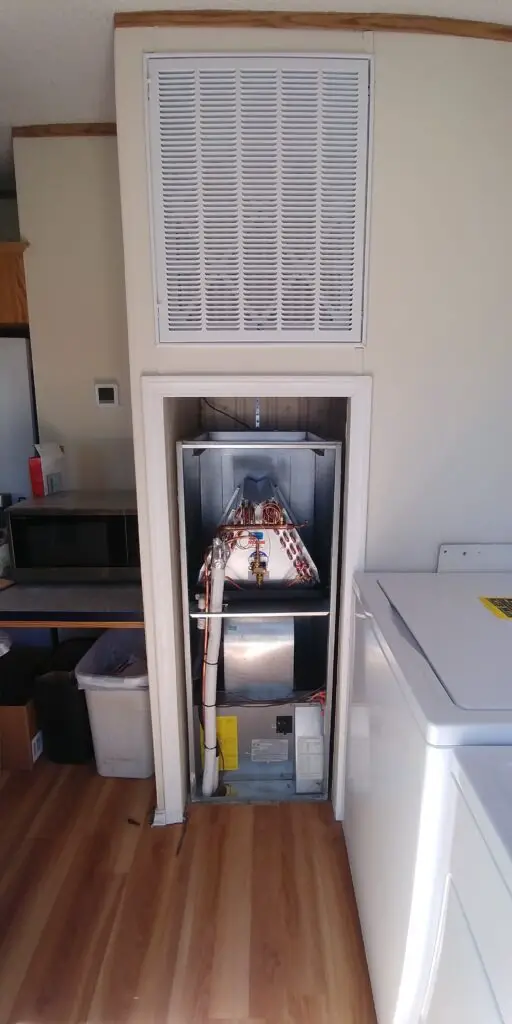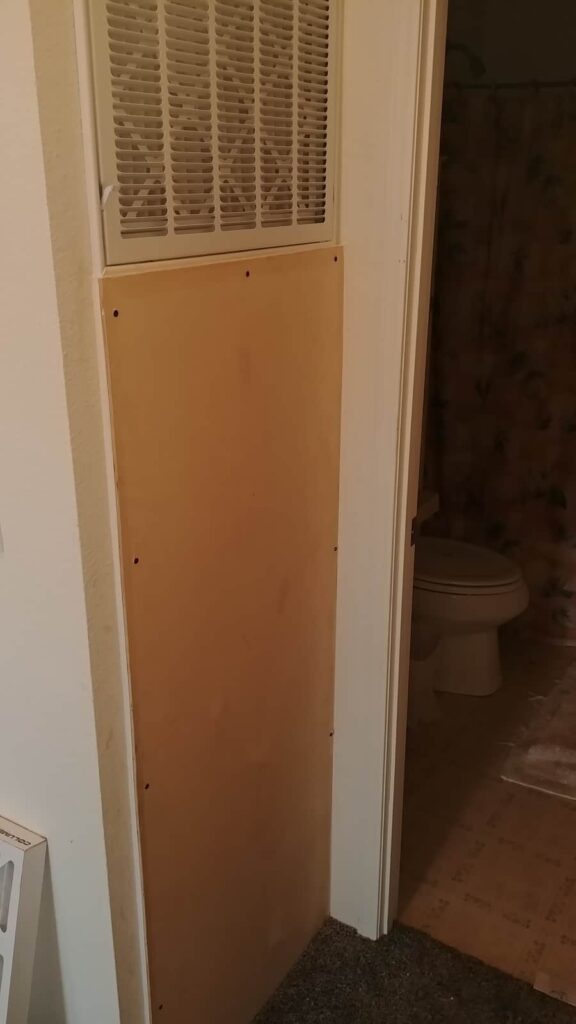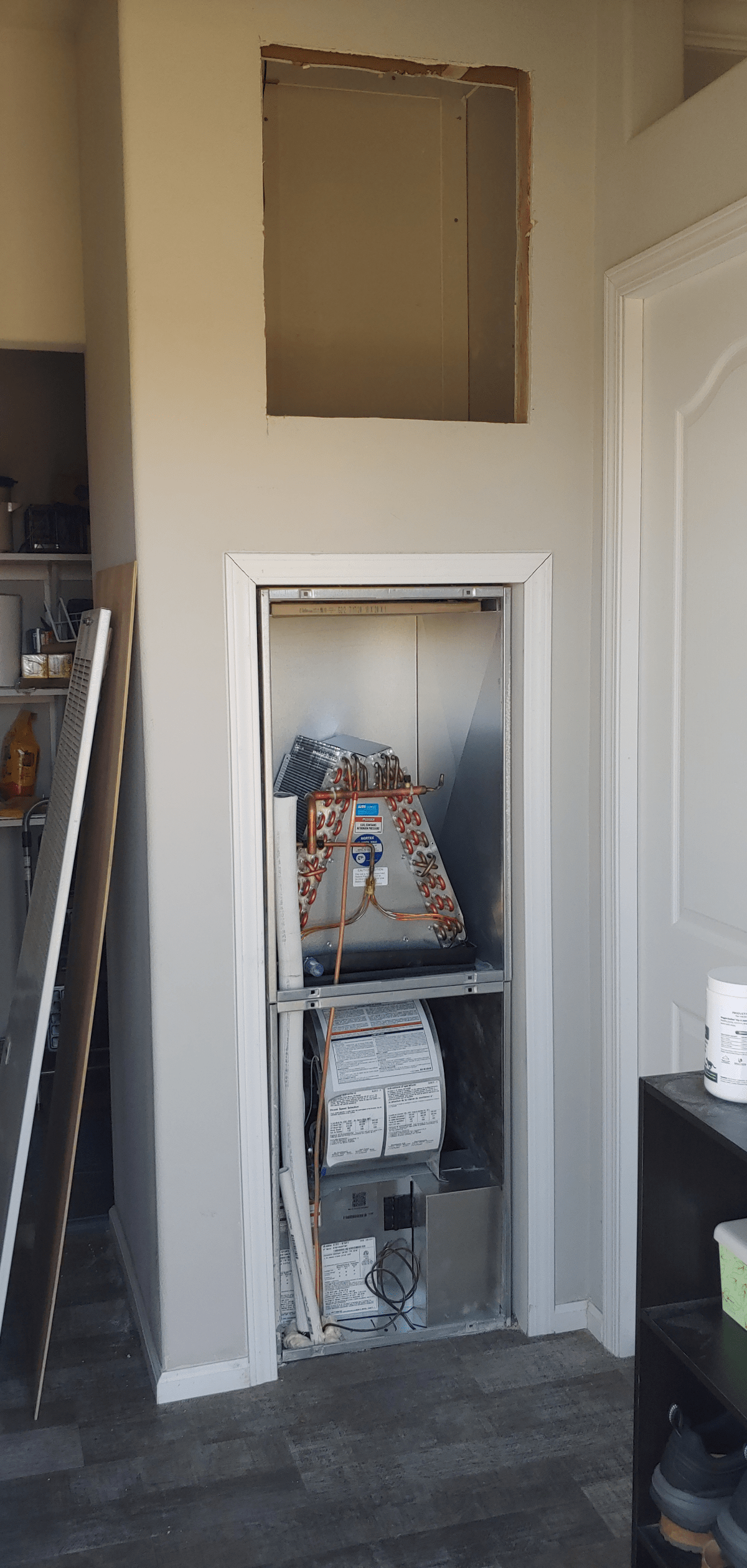Mobile home furnaces are loud because of the openness of the furnace to the living area and excessive air velocity through undersized ductwork.
In most manufactured homes, cold air returns are virtually nonexistent. Not enough return air ducting is the main problem with manufactured home furnace noise.
The small warm air supply duct system increases air velocity and noise, like blowing through a straw. That’s how your furnace feels.
I realize that not all manufactured homes have the same type of heating system. The furnace in your manufactured home may be configured or installed quite differently. I am writing this article to describe the mobile home furnace installations I have experienced. I hope you can use some of my ideas and experience to make your system quieter.
What To Do If Your Furnace Is Making Noise
You can fix a loud manufactured home furnace yourself or hire your local handyperson to install a larger filter relocated above the furnace and a door over the furnace closet.
The door is a straightforward DIY project. Buy a nice-looking sheet of quarter-inch plywood and cut it slightly larger than the furnace cavity.
I’ve done some research and have been in many manufactured homes. These mobile home heating systems are almost all noisy enough to affect your TV volume.
A manufactured home furnace is too loud when you have to turn the volume up when the furnace cycles on and turn the volume down when the noisy thing goes off.
Or maybe you want to quiet the furnace down. Above is a mobile home furnace with doors and a filter grill removed. Even with the furnace doors on, there is nothing to block the noise from the furnace.
Cut the plywood to completely cover the furnace compartment. Then, fasten the cover over the opening. Remember that it should make a good seal to keep dust and pet hair from seeping in through the cracks.
These filter grilles are available on Amazon (ad). I could only find them to fit a one-inch thick filter. You can make up for the problem of having one of those flimsy one-inch filters by purchasing a thicker filter made to fit into the new filter frame.

Installing a filter grill just above the furnace takes advantage of the void above your furnace. The cover over the front of the furnace creates a chamber that will help reduce the noise. Keep the filters as large as possible to allow for the best airflow and more prolonged use of filters between changes.
By assessing your system, you may find it easy to get the return grill even further away from the furnace for quieter operation. Remember, it has to seal completely around the door. This includes the bottom of the door. This door is easy to remove with sheet rock screws. If you are a craftsman, build a more appealing door.
If the door doesn’t make a good seal, it won’t take long for you to notice dust collecting around the door.
Dap makes a great product called Seal ‘N Peel. You apply Seal ‘N Peel like any other caulk, and when you need to remove the door, it will easily come off without much effort.
| Dap 18354 Seal ‘N Peel Removable Caulk | Amazon |
Be sure to use a thin bead of white or clear caulk (or Peal ‘N Seal) and paint the door to match the surrounding wall.

In my research, I could only find filter grilles that hold a one-inch thick filter. You can take advantage of a one-inch filter grill by ordering a 5″ thick filter from Amazon (ad) with a lip that fits into the filter grill, and the bulk of the filter fits nicely into the cavity.
| 20x20x5 Practical Pleat 5″ Return Grille Air Filter – MERV 11 | Amazon |
A standard filter size that works best for the average manufactured home is 20 X 20 or 20 X 25. Be sure you buy common sizes, as it makes it much easier to find replacement filters.
Let me show you how to do this and how much it should cost.
Remember that any work you do to change the airflow or alter the duct system should be checked by a qualified technician to ensure no damage to your heating and cooling system will occur.
Manufactured homes come with the poorest air filter systems from the factory. Most furnaces have a little slot to slide in a one-inch filter relative to the depth and width of the furnace. It’s just never good enough.
Furnace manufacturers install filter slots in their equipment because installers take the cheap way out by not adding sufficient filtering. This includes manufactured home manufacturers.
When you remove your dirty furnace filter, a small amount of dirt will fall onto the fan. That dirt then gets blown into the ductwork. After several filter changes, that small amount of dirt makes for some filthy ductwork.
And some types of furnaces have their filters crammed into the furnace door. I often see this with gas furnaces in manufactured homes—another poor solution for home air filtering.
A better filter system keeps the dirt in the filter and then in the garbage, where it belongs, and improves the air quality and the noise.
And, no, you don’t have to buy a new furnace. You can make even an old relic sound so much quieter. It may even be a great little DIY project. You’ll be much happier when you can leave the TV volume at one level.
Specifically, this applies to electric furnaces, with or without cooling units or heat pumps, and in only certain types of furnace closets. The furnace closet should be for just the furnace with no other appliances, but this can be done if the electric water heater is in the same space.
If your manufactured home furnace shares a space with a washer and dryer, modifying your project becomes a little more challenging, but it can still be accomplished. Once you learn my idea of closing off the furnace, you can figure out how to complete the project.
If your manufactured home furnace burns gas or oil, certain issues with combustion air enter the equation, and making your mobile home furnace quieter would be hazardous. Consult a professional before taking on this project.
Fossil fuel furnaces with two PVC vent pipes or a concentric venting system should qualify for enclosing the furnace. Be sure to consult an HVAC professional before enclosing a fossil-burning furnace. You can google your furnace’s model number to determine the venting type or send me pictures.
For your safety, I’d consult someone familiar with combustion venting to see if my new filter method applies. Along with the inherent noise in these furnace installations, you should first determine if the noise is something other than normal fan and air movement through the system.
Blower noise can come from a bad bearing or a wheel rubbing on the fan housing.
Another obvious source of noise and rubbing noise could be the fan motor bracket. A loose or broken bracket will cause the wheel to rub the housing.
Use caution when reaching into tight places. Not long ago, I reached into a blower motor compartment to see how hot it was and slowly removed my hand. Without even so much as an ounce of pain, I had cut open my hand to the tune of 9 stitches. There are some sharp edges inside these furnaces.
Many homeowners ask what the cost of replacing a furnace blower bearing is. Even if you could find a motor repair shop that would repair fractional horsepower motors, the cost would be more than that of a new motor. Then consider that after you pay for the new bearings, you still have the windings and wiring of an old motor that could short and burn.
Changing the fan to a lower speed is possible, even more so with just an electric furnace. A heat pump requires a certain amount of air through the indoor coil and should be at high speed. Not enough airflow could be detrimental to the compressor.
Most fan motors have 3 or 4 speeds. An electric furnace without a heat pump attached can run at the lowest speed. A good service technician can determine this for you. If you have any doubts, it’s well worth a service call to make sure.
Another noise created by these poor duct systems is the warm air supply vent closest to the furnace.
I don’t advise my customers to block airflow in HVAC applications, but there is one vent that I do recommend closing. It’s the supply vent right near the furnace.
The air from these vents located next to the furnace does very little to influence the room temperature because it short cycles right back into the return.
Pull the vent cover off the duct, cut a piece of cardboard to fit the bottom, and tape it on. The better seal you make, the more noise reduction you will notice.
Conclusion
An apology: I didn’t realize that some folks don’t like their manufactured home being called a mobile home. I couldn’t change the title for technical reasons (which I don’t fully understand), so I changed all references.
It’s a shame that the manufactured home industry won’t add simple ideas to reduce noise pollution and improve filtering. It’s a tightly budgeted housing segment and provides an inexpensive way to own a home, but I can’t help but think some ideas could be offered as options.
The filters available for the slot in the furnaces that come in any home are insufficient. They only lead to more maintenance or more repairs without maintenance.
If you’re asking yourself how to replace a manufactured home filter, consider replacing the type of filter and the location to help reduce the noise and increase the filtering capability of the forced air system.

